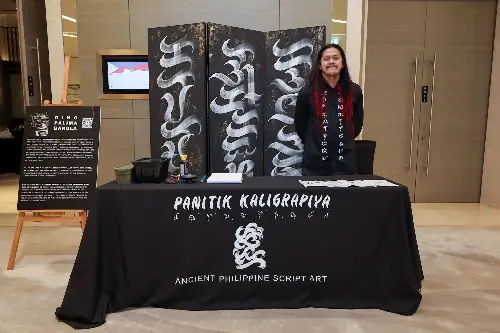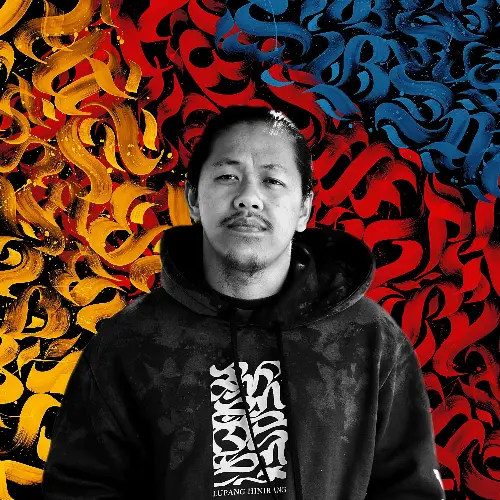
DUBAI, United Arab Emirates – Baybayin, a written form of communication during pre-Hispanic Philippines, is slowly making headways here, not only among overseas Filipinos, but with a growing number of Arab intellectuals, amazed that Pinoys have what to them would be Arabic calligraphy.
What’s even more awesome is that a 34-year-old, high school graduate from Bicol has been spearheading efforts to revive baybayin, regularly holding workshops at the city’s public library through the School of Life program of Dubai Culture, a government agency tasked to preserve cultural heritages.
“My task is to tell our fellow Filipinos who we really are. And that baybayin is one of the means to connect ourselves with our culture. It is something we can put on the table and say, ‘This is us,’” Gino Palima Banola, whose day job is being a 3D designer, said in a mix of English and the vernacular.
Banola, eldest of seven children, said it’s sad that baybayin seems to have taken the back seat while other countries have clung to their own scripts and prospered doing so.
“I think Pilipinas lang ang hindi gumagamit ng kanilang wikang pasulat,” he lamented. (I think only the Philippines doesn’t use its own written language.)
The future
He cited Dubai’s Museum of the Future, emblazoned with Arabic calligraphy as an example, saying it showcases the Arab identity.
“I wish we could integrate baybayin in our daily lives. Look at Dubai. Look at how they love their culture, their script. I know it’s part of their success as a country. They know their identity. And they are embracing it. The Museum of the Future is all in Arabic script, which is incorporated into their vision of the future,” Banola said.

Banola said Arabs and foreign nationals have started attending his workshops. “Naa-amaze sila na meron din pala tayo sariling script. They keep asking me, bakit daw hindi natin ginagamit,” he said.
(They were amazed that we also have our own script. They keep asking why we don’t use it.)
He added: “Baybayin is also our bridge to connect with other cultures, especially here in UAE, which promotes tolerance.”
Banola said there were 60 people who registered in his most recent workshop also held at the public library. “But the venue’s capacity was just for 30,” he said, adding that there were Arabs and Indians in attendance.
Interest
Azza Khair Elseed, project manager of the School of Life program, said there was interest among Emiratis as well as other Arabs and foreign nationals to Banola’s advocacy.
“Yes, absolutely. For the first session, it’s true that the majority of participants were Filipinos, with a few from other nationalities. This is expected, as baybayin is deeply rooted in Filipino culture, and many in the Filipino community feel a strong connection to it.
“However, we’re optimistic that as we continue to cycle through the workshops and expand our outreach, we’ll see more diverse participation. This growth will take time, but with each session, we’re confident that we’ll be able to broaden the audience and foster deeper appreciation for baybayin beyond the Filipino community,” Elseed told Rappler.
She said Banola’s advocacy is a “perfect fit within the School of Life program framework.”
“His efforts to promote baybayin through engaging workshops and activities directly support the program’s mission of sustaining cultural legacies. By introducing baybayin to a broader audience, Gino is not only helping to preserve an essential part of Filipino history but is also fostering inclusivity—an important value of the School of Life program.
“These workshops encourage participants to explore and appreciate Filipino culture, and by promoting cross-cultural dialogue, Gino’s advocacy embodies the program’s commitment to cultural exchange and mutual understanding. As the workshops continue, we’re confident that they will spark greater interest and participation, further contributing to the program’s goals of community engagement and heritage conservation,” she said.
Fellow Filipinos at the workshops were happy and interested, Banola said. “Baybayin was not extensively taught to us in school,” he said.
He said the challenge is on promoting baybayin in an increasingly digital world where almost nobody writes in cursive anymore.
Goosebumps
And so, it happened one day, when Banola wrote baybayin on his child’s whiteboard and got goosebumps.
“Habang sinusulat ko sya, I discovered this connection sa ating kultura. I felt being more Filipino. (I discovered this connection with our culture while I was writing it. I felt being more Filipino.)
He said it’s lamentable in a way that “in these modern times, we don’t write in cursive, especially so that everything has gone digital.
“Somehow this separates us from our identity.”
Brush strokes
Banola merges traditional brush strokes with modern technology to promote the Filipino ancient script to a global audience. He made history to be the first Filipino script calligrapher to display baybayin script in 360-degree digital platform.
This original artwork was recently displayed during an event celebrating the Filipino language, dubbed “Sulyap,” (Glance) held in Theatre Of Digital Arts Dubai, and organized by Tribe Creatives, a collective of Filipino intellectuals and professionals.
The Philippine Consulate General here also supports Banola’s advocacy.
“There are more Filipino groups, artists and influencers who want to help in this movement, adopting baybayinm as well in their works,” he said.
History
Filipino historian, Ambeth R. Ocampo said there have been accounts that baybayin was widely used before the Spaniards arrived in the Philippines, citing a Jesuit priest, Fr. Pedro Chirino, who documented the pre-Spanish syllabary as having three vowels and twelve consonants, and provided the key to reading and writing it.
In his Facebook post, Ocampo said it is “significant that Chirino acknowledged… there was universal literacy in our own writing system, declaring that: ‘All these islanders are much given to reading and writing and there is hardly a man, and much less a woman, who does not read and write in the letters used in the island of Manila.’”
The question is, Ocampo noted, “how come not a single document from this period survived?
“Or maybe one or two of these early documents are just lying around in a foreign archive or library waiting to be found.” – Rappler.com
